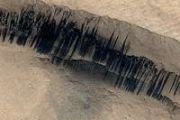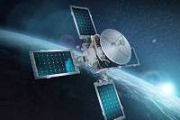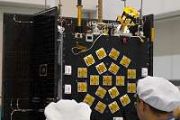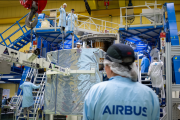
Copernical Team
ESA ground facilities support ISRO's Chandrayaan-3 lunar mission
 The European Space Agency (ESA) is set to support the Chandrayaan-3 mission, launched by the Indian Space Research Organisation (ISRO). This Moon mission features a lunar lander and a rover, tasked to perform scientific operations on the lunar surface for a period of 14 days. To ensure the mission's success, ground stations worldwide, coordinated by ESA and NASA, are se
The European Space Agency (ESA) is set to support the Chandrayaan-3 mission, launched by the Indian Space Research Organisation (ISRO). This Moon mission features a lunar lander and a rover, tasked to perform scientific operations on the lunar surface for a period of 14 days. To ensure the mission's success, ground stations worldwide, coordinated by ESA and NASA, are se India to try again to land spacecraft on the moon
 After a disheartening 2019 moon landing failure, India's lunar exploration effort will resume Friday with the planned launch of Chandrayaan-3, a sophisticated, automated mission to touch down softly and demonstrate how its rover can navigate the surface.
Liftoff is planned for 5:05 p.m. EDT from the Satish Dhawan Space Station in Andhra province of Sriharikota just above Chennai on the sou
After a disheartening 2019 moon landing failure, India's lunar exploration effort will resume Friday with the planned launch of Chandrayaan-3, a sophisticated, automated mission to touch down softly and demonstrate how its rover can navigate the surface.
Liftoff is planned for 5:05 p.m. EDT from the Satish Dhawan Space Station in Andhra province of Sriharikota just above Chennai on the sou Sols 3887-3888: The Vastness
 Earth Planning Date: Wednesday, July 12, 2023 - A blue hue inches over the horizon illuminating a sea of rocks scattered across the landscape like the scales of a fish. Among the sea, alone in the vastness, a rover sleeps. The time is now 9:25, in a "time zone" defined for itself. The waking rover receives instructions from a tiny speck of light, far away and slowly creeping towards the other si
Earth Planning Date: Wednesday, July 12, 2023 - A blue hue inches over the horizon illuminating a sea of rocks scattered across the landscape like the scales of a fish. Among the sea, alone in the vastness, a rover sleeps. The time is now 9:25, in a "time zone" defined for itself. The waking rover receives instructions from a tiny speck of light, far away and slowly creeping towards the other si ESA Astronauts Embark on Lunar Geology Training in Norwegian Wilderness
 In the hush of a Norwegian fjord, under the spectral glow of a waning crescent Moon, ESA astronauts Alexander Gerst and Samantha Cristoforetti have started their journey into lunar geology. The astronauts have been meticulously prepared for their first field expedition, equipped with digitally enhanced toolkits and bracing for the rigors of ESA's PANGAEA course.
Adorned in state-of-the-art
In the hush of a Norwegian fjord, under the spectral glow of a waning crescent Moon, ESA astronauts Alexander Gerst and Samantha Cristoforetti have started their journey into lunar geology. The astronauts have been meticulously prepared for their first field expedition, equipped with digitally enhanced toolkits and bracing for the rigors of ESA's PANGAEA course.
Adorned in state-of-the-art Euclid's large halo around indefinitely small point
 If you think it's only possible to be held in orbit around a physical 'thing' with a large mass - a planet or a star, say - you'd be wrong. It is in fact possible to orbit around an invisible point, an oasis of forces, infinitesimal in size. ESA's Euclid mission was launched on 1 July 2023 to uncover the secrets of the dark universe. Its destination? Like many astronomy missions before it, Lagra
If you think it's only possible to be held in orbit around a physical 'thing' with a large mass - a planet or a star, say - you'd be wrong. It is in fact possible to orbit around an invisible point, an oasis of forces, infinitesimal in size. ESA's Euclid mission was launched on 1 July 2023 to uncover the secrets of the dark universe. Its destination? Like many astronomy missions before it, Lagra Rocket Lab to boost Synspective's satellite constellation with more launches
 The US-based small satellite launch service provider, Rocket Lab USA, Inc. (Nasdaq: RKLB), has recently signed a deal with Japan's Synspective, an Earth imaging company, for two dedicated Electron launch missions. With this development, Synspective's contracted missions with Rocket Lab have now been extended to a total of six, reflecting the strong and evolving collaboration between the two ente
The US-based small satellite launch service provider, Rocket Lab USA, Inc. (Nasdaq: RKLB), has recently signed a deal with Japan's Synspective, an Earth imaging company, for two dedicated Electron launch missions. With this development, Synspective's contracted missions with Rocket Lab have now been extended to a total of six, reflecting the strong and evolving collaboration between the two ente CASIC plans new satellite network by 2030
 China Aerospace Science and Industry Corporation (CASIC), a leading Chinese space contractor has revealed plans to create an expansive remote-sensing satellite network by the end of this decade. The announcement, made on Thursday, is an impressive testament to the ongoing advancements in China's space exploration and surveillance capabilities.
Managed by CASIC Space Engineering Development
China Aerospace Science and Industry Corporation (CASIC), a leading Chinese space contractor has revealed plans to create an expansive remote-sensing satellite network by the end of this decade. The announcement, made on Thursday, is an impressive testament to the ongoing advancements in China's space exploration and surveillance capabilities.
Managed by CASIC Space Engineering Development Uniting Europe: DLR Spearheads Responsive Satellite Deployment Network
 The rapidly expanding realm of information technology is ever-dependent on unobstructed access to space-based data and communication networks, bringing the need for technical mechanisms that can safeguard, repair, reinforce, or develop essential space infrastructures to the forefront.
Ensuring new satellites can be placed and activated in orbit within a matter of hours or days is of prime
The rapidly expanding realm of information technology is ever-dependent on unobstructed access to space-based data and communication networks, bringing the need for technical mechanisms that can safeguard, repair, reinforce, or develop essential space infrastructures to the forefront.
Ensuring new satellites can be placed and activated in orbit within a matter of hours or days is of prime Webb Telescope catches glimpse of possible first-ever 'dark stars'
 Austin TX (SPX) Jul 14, 2023
Stars beam brightly out of the darkness of space thanks to fusion, atoms melding together and releasing energy. But what if there's another way to power a star?
A team of three astrophysicists - Katherine Freese at The University of Texas at Austin, in collaboration with Cosmin Ilie and Jillian Paulin '23 at Colgate University - analyzed images from the James
Austin TX (SPX) Jul 14, 2023
Stars beam brightly out of the darkness of space thanks to fusion, atoms melding together and releasing energy. But what if there's another way to power a star?
A team of three astrophysicists - Katherine Freese at The University of Texas at Austin, in collaboration with Cosmin Ilie and Jillian Paulin '23 at Colgate University - analyzed images from the James China's methane-fueled rocket achieves global first with successful orbital insertion
 The first successful orbital mission of a methane-fueled rocket has been accomplished by China, a significant breakthrough in the utilization of low-cost and environmentally friendly liquid propellants for carrier rockets. The rocket, known as ZQ 2 or Rosefinch 2, launched from the Jiuquan Satellite Launch Center located in China's northwestern Gobi Desert on Wednesday morning.
The Beijing
The first successful orbital mission of a methane-fueled rocket has been accomplished by China, a significant breakthrough in the utilization of low-cost and environmentally friendly liquid propellants for carrier rockets. The rocket, known as ZQ 2 or Rosefinch 2, launched from the Jiuquan Satellite Launch Center located in China's northwestern Gobi Desert on Wednesday morning.
The Beijing 




























